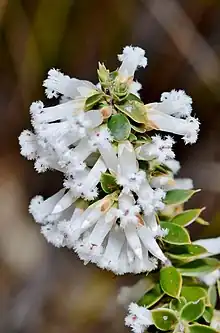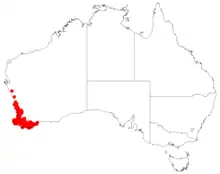| Styphelia erubescens | |
|---|---|
 | |
| Scientific classification | |
| Kingdom: | Plantae |
| Clade: | Tracheophytes |
| Clade: | Angiosperms |
| Clade: | Eudicots |
| Clade: | Asterids |
| Order: | Ericales |
| Family: | Ericaceae |
| Genus: | Styphelia |
| Species: | S. erubescens |
| Binomial name | |
| Styphelia erubescens | |
 | |
| Occurrence data from AVH | |
| Synonyms[1] | |
.jpg.webp)
Styphelia erubescens is a species of flowering plant in the heath family Ericaceae and is endemic to the south-west of Western Australia. It is an erect shrub with variably-shaped leaves with a small, sharp point on the tip, and white, pink or red, tube-shaped flowers.
Description
Styphelia erubescens is an erect shrub that typically grows to a height of 0.1–1 m (3.9 in – 3 ft 3.4 in) and often has spreading branches. Its leaves are sessile, 6–12 mm (0.24–0.47 in) long, linear, oblong or lance-shaped, sometimes egg-shaped with the narrower end towards the base, but with a small, sharp point on the tip. The flowers are usually borne singly or pairs in leaf axils on a short peduncle with tiny bracts, and broad bracteoles less than half as long as the sepals. The sepals are about 3 mm (0.12 in) long, the petals white, pink or red, nearly 8 mm (0.31 in) long and joined at the base, forming a tube much longer than the sepals. Flowering occurs from March to December.[2][3]
Taxonomy
Styphelia erubescens was first described in 1867 by Ferdinand von Mueller in his Fragmenta phytographiae Australiae.[4][5] The specific epithet (erubescens) means "reddening", referring to the colour of the flowers.[6]
Distribution and habitat
This styphelia occurs in a variety of soils in near-coastal sites, in wetland, and on hills, ridges and breakaways in the Avon Wheatbelt, Esperance Plains, Jarrah Forest, Mallee, Swan Coastal Plain and Warren bioregions of southern Western Australia.[7]
Conservation status
Styphelia erubescens is listed as "not threatened" by the Western Australian Government Department of Biodiversity, Conservation and Attractions.[7]
References
- 1 2 "Styphelia erubescens". Plants of the World Online. Retrieved 14 December 2023.
- ↑ Bentham, George; von Mueller, Ferdinand (1868). Flora Australiensis. Vol. 4. London: Lovell Reeve & Co. p. 219. Retrieved 25 March 2023.
- ↑ "Leucopogon oxycedrus". FloraBase. Western Australian Government Department of Biodiversity, Conservation and Attractions.
- ↑ "Styphelia erubescens". APNI. Retrieved 14 December 2023.
- ↑ von Mueller, Ferdinand (1867). Fragmenta phytographiae Australiae. Melbourne: Victorian Government Printer. p. 33. Retrieved 14 December 2023.
- ↑ Sharr, Francis Aubi; George, Alex (2019). Western Australian Plant Names and Their Meanings (3rd ed.). Kardinya, WA: Four Gables Press. p. 193. ISBN 9780958034180.
- 1 2 "Styphelia erubescens". FloraBase. Western Australian Government Department of Biodiversity, Conservation and Attractions.